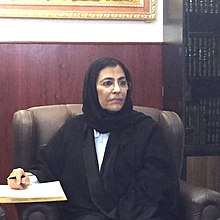Fahda bint Saud Al Saud
| Fahda bint Saud bin Abdulaziz Al Saud | |||||
|---|---|---|---|---|---|
| Her Royal Higness Princess | |||||
 Fahda bint Saud bin Abdulaziz during a visit to a local orphanage | |||||
| Born |
1953 (age 64–65) Riyadh, Saudi Arabia | ||||
| Spouse | Baron Abdullah (previously Kurt) Bergstrøm (deceased in 1990) | ||||
| Issue | Abdulaziz Abdullah Bergstøm | ||||
| |||||
| House | House of Saud | ||||
| Father | King Saud | ||||
| Mother | Jamila bint Assad bin Ibrahim Al Mirhi | ||||
| Religion | Wahhabi Hanbali Sunni Islam | ||||
Fahda bint Saud bin Abdulaziz Al Saud (born 1953) is a Saudi Arabian artist and a member of House of Saud.
Early life and education
Princess Fahda was born in 1953.[1] She is daughter of King Saud.[2] Her mother is princess Jamila bint Assad bin Ibrahim Al Mirhi.[1][3]
Princess Fahda received primary educational at (THE KARIMAT HIGH SCHOOL ) in Riyadh until 1964.[4] Then in 1969, she graduated from the Beirut Evangelical School for girls (BESG) in Beirut.[5] She received her bachelor's degree in political science from Beirut College for Women (now the Lebanese American University) in 1974.[4] She then obtained a masters degree in political sciences from the American University of Beirut in 1976. She then studied at the School of Oriental and African Studies for one year.[4] There she participated in a non-degree research courses in the department of political science.[5] Later, she moved to Paris to study art and was trained by late Iraqi artist Issam Al Said on Islamic geometric patterns .[4]
Activities
Princess Fahda is the founder as well as the head of( publishing and archiving) at The King Saud Library which collects, archives and publishes the history and legacy of King Saud.[6]
Princess Fahda also sits as the president of Al Faisaliyya Women's Welfare Society in Jeddah which she's chaired for over two decades, as well as head of Sleysla, a Cooperative Society, specialized in modernizing Saudi handy crafts and fashion in the city of jeddah using locally sourced raw materials with locally inspired TRADITIONAL designs and employing local women to produce them.[7]
Princess Fahda participated in some exhibitions that have feminist focus through her watercolours.[2] One of such exhibitions was organized by the Royal Society of Fine Arts in Jordan and the Pan-Mediterranean Women Artists Network of Greece to eliminate the negative stereotypes concerning women across the Islamic world.[8] The first exhibition was in Australia under the organization of the Interfaith Centre of Melbourne from 25 January to 23 March 2008.[9] Princess Fahda's watercolour work in this exhibition entitled Three Women is a visual representation of the Japanese Golden Rule “See no evil, hear no evil, speak no evil” so dominant in the Islamic world.[8] She herself also organized exhibitions mainly concerning with her father's memory.[2] Additionally, Princess Fahda supported the exhibitions of other artists in Saudi Arabia, for instance that of Farha Sayeed, an Indian artist who focuses on decoration of eggs.[10]
Princess Fahda painted the pictures of the book dedicated to her father published by King Saud foundation that was seen as part of the rehabilitation of King Saud.[11] She is president of the Al Faisaliyah women’s welfare society, that is a Jeddah-based organization mainly targeting women.[4][5]
Views
Princess Fahda , wrote several articles on different topics in leading Saudi newspapers such as Okaz and Arab News , relating to social issues ,and Saudi history ..[12]
In February 2007, her article entitled "Saudi women's concerns" was published in Al Hayat. There Princess Fahda clearly expressed that debate continuing about the rights of women in Saudi society has been "pivotal to the nation's renaissance."[13] However, she is described as a traditionalist, but not a reactionary. She supports reform towards women, but largely depending on the country’s own values, including religious values.[14]
Interview with Fahda bint Saud was one of the interviews included in Mona Almunajjed's book entitled Saudi Women Speak: 24 Remarkable Women Tell Their Success Stories, published in 2011 by the Arab Institute for Research and Publishing in Amman and Beirut.[15]
Personal life
Fahda bint Saud has one child, a son, Abdulaziz. She was divorced from Baron Abdullah Kurt Bergstrøm, who died later in 2000,a Danish national who changed his first name to Abdullah when converting to Islam.[16]
References
- 1 2 "Fahda bint Saud Al Saud". Retrieved 6 December 2016.
- 1 2 3 "Greenbox dictionary of Saudi Arabian artists". Greenbox Museum. Retrieved 16 May 2012.
- ↑ "Royal Family Directory". Datarabia. Retrieved 14 December 2016.
- 1 2 3 4 5 Al Tamimi, Jumana (16 August 2007). "Women, veils and the vain West". Gulf News. Retrieved 16 May 2012.
- 1 2 3 "Princess Fahda bint Saud al Saud". Who's Who Arab Women. Archived from the original on 18 October 2013. Retrieved 16 May 2012.
- ↑ "About Us" The King Saud Library
- ↑ "Sleysla Centre" Traditional Saudi Handicrafts in Jeddah
- 1 2 Morillo, Enith (27 January 2010). "Exhibition: Breaking the veils: Women artists from the Islamic world". Altmuslimah. Retrieved 25 August 2012.
- ↑ "Breaking the Veils: Women Artists from the Islamic World" (PDF). Euromedi. Retrieved 25 August 2012.
- ↑ "About the Artist". Farha Sayeed. Retrieved 25 August 2012.
- ↑ "New Book". King Saud Foundation. Retrieved 16 May 2012.
- ↑ "Saudi Princess Fahda bint Saud ibn Abdulaziz: Conspiracy Theories and Other Writings". Memri. 2 February 2004. Retrieved 16 May 2012.
- ↑ Coopman, Pierre (24 November 2008). "Arab Media Debates Status of Saudi Women". Arab Press Network. Retrieved 16 May 2012.
- ↑ "On Women's Reform". Crossroads Arabia. Archived from the original on 29 September 2015. Retrieved 7 June 2012.
- ↑ Wilson-Goldie, Kaelen (2011). "More talk, less distortion". The Daily Star. Retrieved 20 August 2012.
- ↑ "Daughters and sons of King Saud". King Saud.net. Archived from the original on 13 September 2013. Retrieved 16 May 2012.